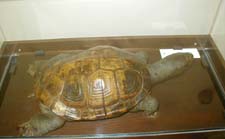
|
|
|
|
Related Links: |
|
Giving New Life to UMD's Original Testudo
By Taashi Rowe After years of collecting dust in a box inside McKeldin Library, the diamondback terrapin that became the model for the University of Maryland mascot was cleaned up and trotted out for visitors Thursday--in time for homecoming weekend. About 40 people–including five members of the class of 1933–showed up to see the long-dead Testudo stretched out in a glass-encased, temperature-controlled home at Hornbake Library. The five were students when the terrapin usurped other campus mascots at the suggestion of then-football coach and future campus president Harry C. Byrd. “There was talk that we needed a [new] mascot," to replace Old Liners and Aggies, said Harry Hasslinger of the class of '33. "Harry Byrd suggested the diamondback terrapin, because there were lots of them in Crisfield [Maryland],” Hasslinger said. The turtle is native to the Chesapeake Bay. “Turtles had a hard shell and were slow going, but [would] accomplish” their mission, Hasslinger said. The shift of that first terrapin mascot to Hornbake began in 1999, when Anne Turkos, university archivist, and Yvonne Carignan, head of the Libraries Preservation Department, decided they wanted to ensure that it would remain well-preserved for years to come. They hired Cathy Hawks, a private conservator, to work on the already-stuffed turtle. Hawks said Thursday that before she undertook the conservation process, she had to do some research into Testudo’s past. Based on the original Testudo’s large hind feet, it was most likely a female, she said.
Hawks discovered the terrapin had come from Crisfield around 1933 and had had one great journey in her life. That was a trip on a train in 1933 to Providence, R.I., to be used as a model for the first Testudo sculpture. (That bronze sculpture—partly funded by the class of ’33--now sits proudly in front of McKeldin Library. Hasslinger, the last surviving member of the Testudo committee, said he and classmates helped raise funds for the sculpture by printing limited copies of the year book and holding their senior prom on campus instead of in a hotel.) Before Hawks treated the turtle, Testudo had a gap on one side of her head, was covered with dust, and had suffered some damage to her shell due to humidity. Hawks said it took about a day for her to clean the terrapin, apply a conservation treatment and repair some damages with acrylic resin. Hawks and Turkos then collaborated to design Testudo’s new home. Hawks said she wanted to make sure the terrapin would be handled safely in the future and that she would no longer be exposed to humidity, which could cause further destruction to her shell. Testudo’s new home on the second floor of Hornbake is a customized, sealed display case with a humidity-controlled compartment, powder-coated aluminum to prevent fading and security features. The case is set at 55 degrees at all times. The project cost $2,419 in university and private funds, Carignan said. Hasslinger said he was glad to see the terrapin had had such a lasting impact on the campus. "I'm glad [Testudo] survived," he said. "He has proved himself over 70 years." Copyright ©
2002 University of Maryland College of
Journalism
|

